We had an uneventful, even boring, train ride from Gdansk to Berlin and arrived a little earlier than we were able to check into our hotel, so we went for a wander nearby. Literally around the corner from where we are staying is the famous Checkpoint Charlie.
 Checkpoint Charlie or what was really just, “Checkpoint C”, was what the Western Allies took to calling the most well known Berlin Wall crossing between East and West Berlin throughout the entire period of the Cold War (1947–1991). For any young whipper-snappers who can’t remember why the Berlin Wall existed here’s a TL;DR didn’t study history version:
Checkpoint Charlie or what was really just, “Checkpoint C”, was what the Western Allies took to calling the most well known Berlin Wall crossing between East and West Berlin throughout the entire period of the Cold War (1947–1991). For any young whipper-snappers who can’t remember why the Berlin Wall existed here’s a TL;DR didn’t study history version:
In the early ’50s, the Soviet had control of the entire Eastern Bloc of Europe including Eastern Germany, however people were emigrating through the German borders into western occupied areas pretty easily, especially through the city sector borders between East and West Berlin which was very accessible and it was stupidly controlled by four different occupying powers – leading to a left hand rarely knew what the right hand was doing situation. So… they closed the border entirely in 1952 and installed a barbed-wire fence and checkpoint access areas. But even so, some 3.5 million Eastern Germans left over the following decade, which was nearly 20% of the East German population.

The biggest problem with that was that the people fleeing tended to be young educated professional types which meant that the economy of Eastern Germany started to flail with all their engineers, doctors, teachers, lawyers etc., buggering off. To stop the brain drain the Soviets erected a permanent concrete wall with a tall steel-mesh fence running along a “death strip” (yeah, nice name hey) which was covered with mines, and had large areas of freshly ploughed earth, to slow down what were no longer ’emigrants’ but ‘escapees’ so plenty of people got caught or shot trying to escape the Soviets, there was a famous standoff of over 100 US and Soviet tanks here because some American Diplomat wanted to go to the opera and they didn’t think the border guards had a right to check his papers… and all sorts of nasty shit went down over the four decades or so that the Wall stood. The Wall eventually came down on November 9, 1989 (I can still remember watching all the partying on the news), but Checkpoint Charlie stayed in place until the official reunification of Germany in October 1990. Today’s it’s a tourist location and nothing else – complete with a McDonald’s – and no barbed-wire anywhere… and that will be the shortest and potentially most inaccurate TL;DR of the Berlin Wall you’ll ever read.
Even at 4pm on a Sunday afternoon with temperatures barely hitting 3C the area is crawling with tourists trying to get their photo with the paid actors who are dressed up like the military police here. It’s a place that represents a fairly dark chapter in Berlin’s history, but it feels like people have forgotten why they come here.


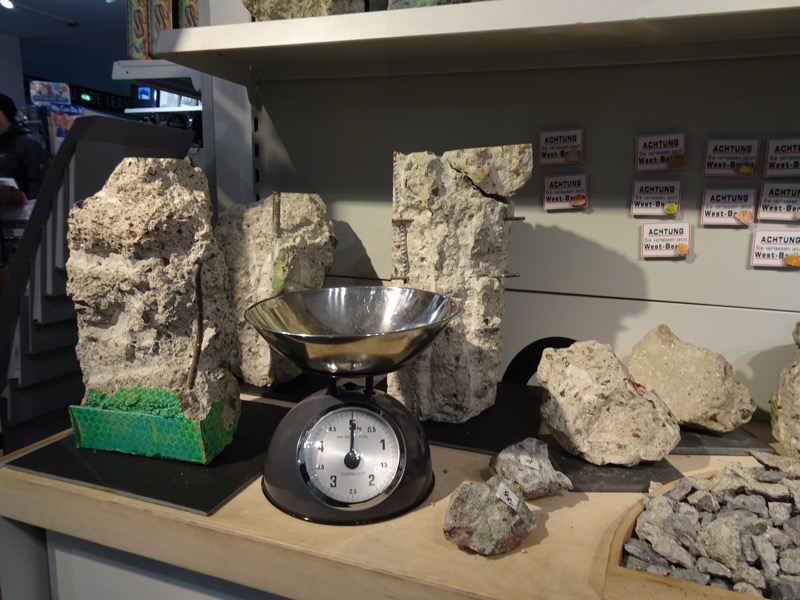
You can buy chunks of Wall here – they sell it by the pound and it is all certified as genuine by the Berlin Wall Museum. What are they going to do when they run out?
Around the corner from Checkpoint Charlie is the Deutsches Currywurst Museum, which opened in 2009, roughly 60 years after the invention of currywurst. Currywurst was apparently invented in 1949 by a Berliner, Herta Heuwer, and the local curry sausages have reached iconic, cult-like status in Berlin, rapidly becoming a staple in the German diet. I kinda love that the Japanese took curry that they encountered through the British who found it in India and made it their own Japanese thing, and the Germans appear to have done something similar. Curry is awesome – the museum, however, is thinly veiled excuse to sell currywurst… which pretty much sells itself anyway. By now, we could access the hotel and went back and went splat. We have a huge room with a separate powder room, two TVs and a living room, which means I obviously booked something way more swish than intended. You never can tell by the photos online. So be it. Slept like a dead thing and had a great breakfast at the hotel before heading out via the underground towards Alexanderplatz to start some serious touristing for the day… the only downside to our plan: it’s fucking MONDAY and nothing in Europe opens on MONDAY.
By now, we could access the hotel and went back and went splat. We have a huge room with a separate powder room, two TVs and a living room, which means I obviously booked something way more swish than intended. You never can tell by the photos online. So be it. Slept like a dead thing and had a great breakfast at the hotel before heading out via the underground towards Alexanderplatz to start some serious touristing for the day… the only downside to our plan: it’s fucking MONDAY and nothing in Europe opens on MONDAY. Below is the Volksbühne which means, the “People’s Theatre” which was built in the early 1900s and was designed to promote accessible theatrical productions at prices that were affordable to the everyday worker – it is now considered to be Berlin’s most iconic theatre, complete with its integrated Franz Metzner sculpture out front. Like most of Berlin it was heavily damaged during WWII, but as far as I can find out – it never burned down, which is quite unusual around here.
Below is the Volksbühne which means, the “People’s Theatre” which was built in the early 1900s and was designed to promote accessible theatrical productions at prices that were affordable to the everyday worker – it is now considered to be Berlin’s most iconic theatre, complete with its integrated Franz Metzner sculpture out front. Like most of Berlin it was heavily damaged during WWII, but as far as I can find out – it never burned down, which is quite unusual around here. Close to Alexanderplatz is the Fernsehturm Berlin television tower. It was built in 1965-69 by the German Democratic Republic (GDR) government and was meant to be a symbol of Communist power in Berlin. Today it has mainly become just an iconic symbol of the city (much like the Eiffel Tower is of Paris) and it can be seen from nearly everywhere in the central city. The ‘Toothpick’ or ‘Telespargel’ (TV-asparagus) as people often call it, is 368m making it the tallest structure in Germany.
Close to Alexanderplatz is the Fernsehturm Berlin television tower. It was built in 1965-69 by the German Democratic Republic (GDR) government and was meant to be a symbol of Communist power in Berlin. Today it has mainly become just an iconic symbol of the city (much like the Eiffel Tower is of Paris) and it can be seen from nearly everywhere in the central city. The ‘Toothpick’ or ‘Telespargel’ (TV-asparagus) as people often call it, is 368m making it the tallest structure in Germany.
 Alexanderplatz is a large public square and transport hub and is mostly known for locating movies in Berlin – ie: you wouldn’t know that Jason Bourne or James Bond is actually in Berlin if they didn’t end up here at some point. Interesting factoid – it was originally a cattle market outside the old Berlin city fortifications and was named Alexanderplatz because the Russian Emperor Alexander I visited here in 1805.
Alexanderplatz is a large public square and transport hub and is mostly known for locating movies in Berlin – ie: you wouldn’t know that Jason Bourne or James Bond is actually in Berlin if they didn’t end up here at some point. Interesting factoid – it was originally a cattle market outside the old Berlin city fortifications and was named Alexanderplatz because the Russian Emperor Alexander I visited here in 1805. Very Berlinesque fountain…
Very Berlinesque fountain…
 This mosaic (below) is Europe’s largest work of art (by area) and wraps around the entire Haus des Lehrers building. Comprising of over 800,000 individual tiles, the mosaic building is just off the Alexanderplatz and was designed by Hermann Henselmann who with Walter Womacka designed and created the enormous work. It measures 7m high and wraps 125m around the building. The whole thing was created between 1962 and 1964 in cooperation with the collaboration of many other artists.
This mosaic (below) is Europe’s largest work of art (by area) and wraps around the entire Haus des Lehrers building. Comprising of over 800,000 individual tiles, the mosaic building is just off the Alexanderplatz and was designed by Hermann Henselmann who with Walter Womacka designed and created the enormous work. It measures 7m high and wraps 125m around the building. The whole thing was created between 1962 and 1964 in cooperation with the collaboration of many other artists.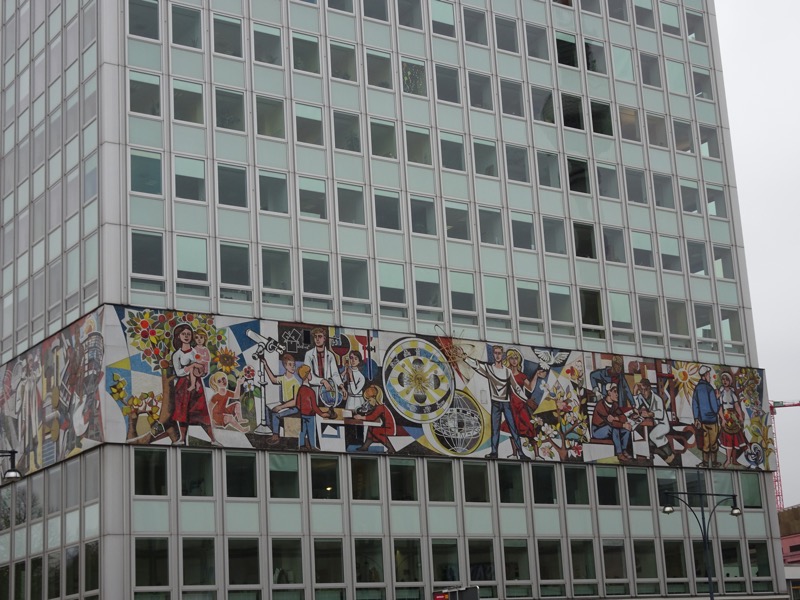 Naturally, being created under the Soviet government in the ’60s, the design is total propaganda, it is supposed to depict the ideal image of a peaceful, modern socialist state.
Naturally, being created under the Soviet government in the ’60s, the design is total propaganda, it is supposed to depict the ideal image of a peaceful, modern socialist state. Nearby is one of Berlin’s most photographed pieces of political street art on the currently empty former Haus der Statistik (House of Statistics) is painted in letters three-stories high, “STOP WARS”. Very simple, yet effective.
Nearby is one of Berlin’s most photographed pieces of political street art on the currently empty former Haus der Statistik (House of Statistics) is painted in letters three-stories high, “STOP WARS”. Very simple, yet effective. The 16 tonnes of Urania World Clock is also located Alexanderplatz (Jason Bourne was here too!) Built in 1969, the Urania World Clock tells time in 148 major world cities.
The 16 tonnes of Urania World Clock is also located Alexanderplatz (Jason Bourne was here too!) Built in 1969, the Urania World Clock tells time in 148 major world cities.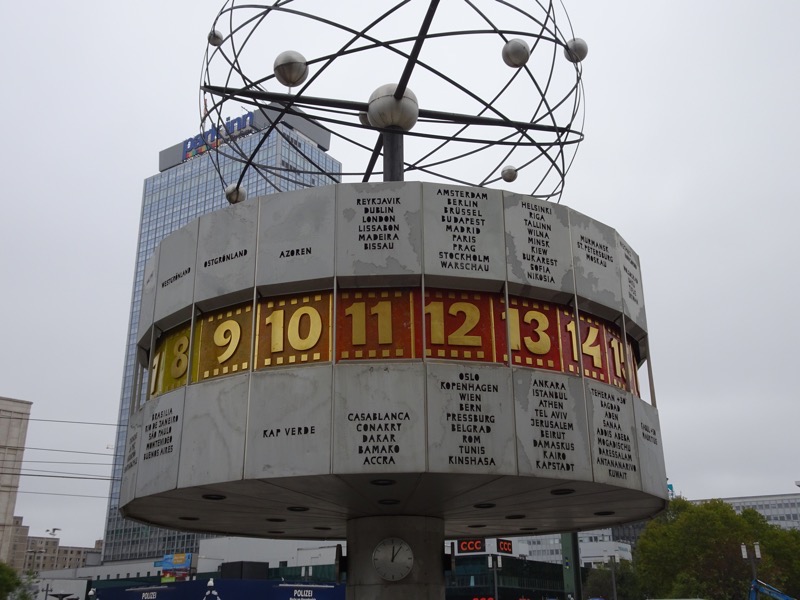

 We then walked not far to the Rotes Rathaus, which is the Red City Hall building, where the governing mayor and the Senate of Berlin are located. It’s quite the landmark with its red clinker bricks and relief sculputres.
We then walked not far to the Rotes Rathaus, which is the Red City Hall building, where the governing mayor and the Senate of Berlin are located. It’s quite the landmark with its red clinker bricks and relief sculputres.
The Rathaus was built between 1861 and 1869 in a high Italian Renasisance style and modelled on a Town Hall in Toruń, Poland, designed by someone named, Hermann Friedrich Waesemann. Before Waesermann designed this town hall that covers an entire city block, there were several smaller buildings here that were used for the city’s administration, some of them dated to the medieval period… makes you want to dig the whole place up and see what’s under it. Something tells me the authorities wouldn’t approve.
Like most of Berlin, the Rathaus was heavily damaged by bombing in WWII and was then rebuilt to the original plans, which took five years from 1951 to 1956. 
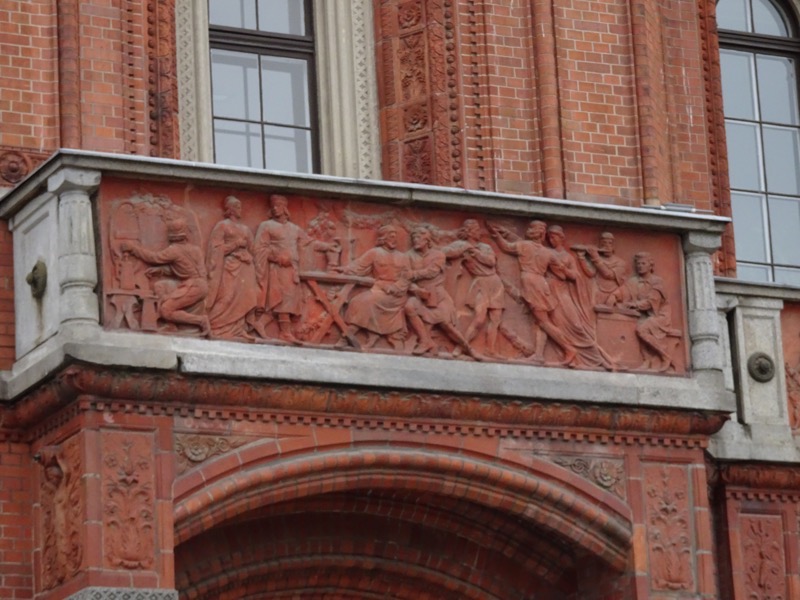 Across the road from the Rathaus is Berlin’s Neptune Fountain (seems to be a thing). This one was built in 1891, designed by Reinhold Begas. The statue depicts the God, Neptune surrounded by four women who represent the four main rivers of Prussia at the time: the Elbe River (the figure holding fruits and ears of corn), the Rhine River (figure with fishnet and grapes), the Vistula (figure holding wooden blocks, symbols of forestry), and Oder River (represented by the figure with the goats and animal skins).
Across the road from the Rathaus is Berlin’s Neptune Fountain (seems to be a thing). This one was built in 1891, designed by Reinhold Begas. The statue depicts the God, Neptune surrounded by four women who represent the four main rivers of Prussia at the time: the Elbe River (the figure holding fruits and ears of corn), the Rhine River (figure with fishnet and grapes), the Vistula (figure holding wooden blocks, symbols of forestry), and Oder River (represented by the figure with the goats and animal skins). 
 There is lots of alligators and turtles and lobsters in among the fountain, yale found it very impressive, but I thought it was nothing compared to My Fountain in Rome. 😉
There is lots of alligators and turtles and lobsters in among the fountain, yale found it very impressive, but I thought it was nothing compared to My Fountain in Rome. 😉 

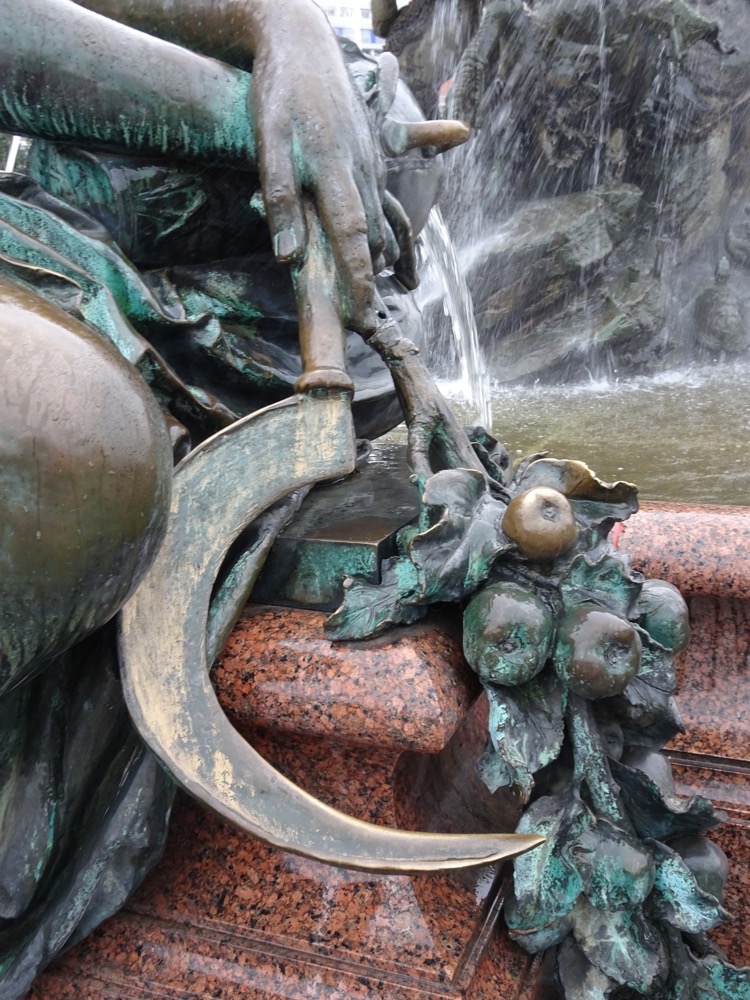

Down the road from the Neptune Fountain is the Berlin Cathedral or the ‘Berliner Dom’ which is the local name for the Evangelical Supreme Parish and Collegiate Church of Berlin. Why these churches need names that are a mile long is beyond me. Anyway the church is located on Museum Island named aptly because it is where all the museums are (MONDAY!). The church that is currently here was completed in 1905 and is a major work of historical architecture from the “Kaiserzefit” (German Empire).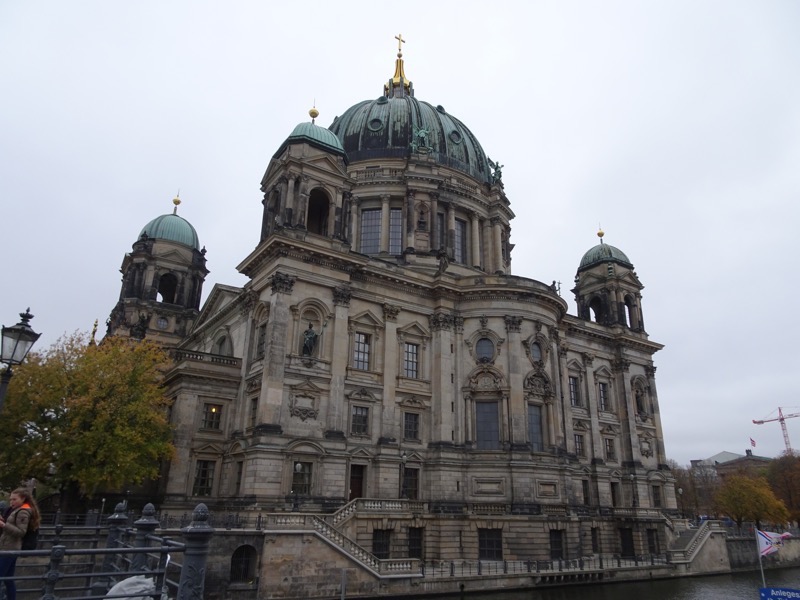 The Berlin Cathedral has never been a ‘proper’ cathedral as it was never the seat of a bishop… sure looks like a cathedral though.
The Berlin Cathedral has never been a ‘proper’ cathedral as it was never the seat of a bishop… sure looks like a cathedral though.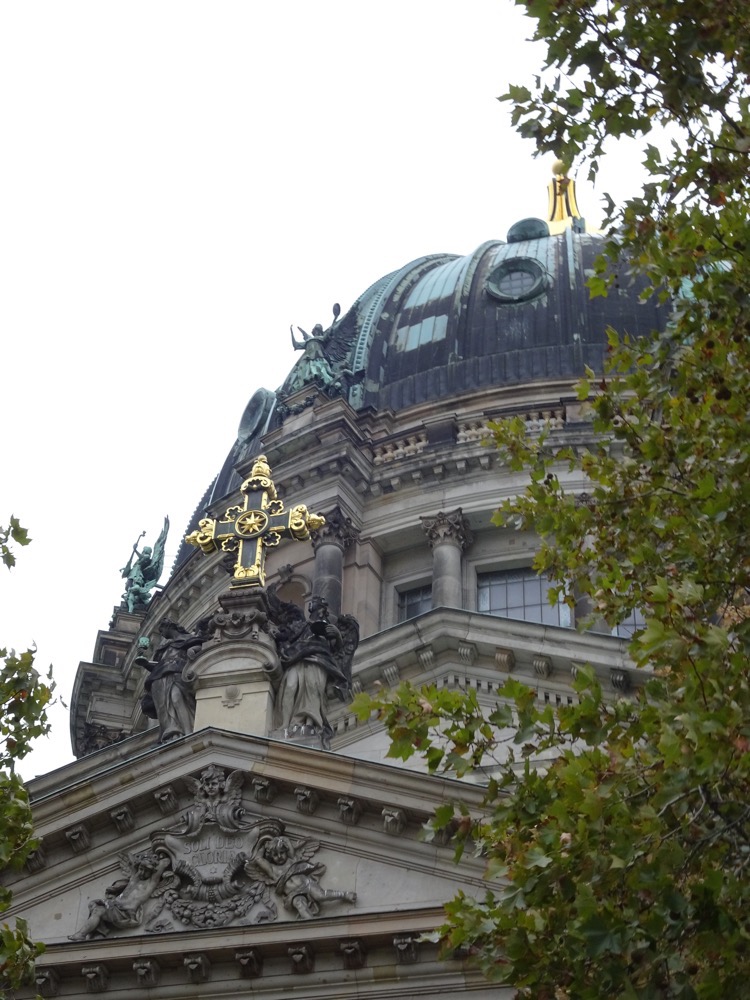
 The inside is remarkable, my photographs do not capture how lavish it is with all its gilded carving, intricate mosaics and shiny marble.
The inside is remarkable, my photographs do not capture how lavish it is with all its gilded carving, intricate mosaics and shiny marble. The church on this site has a long history dating back to the mid 15th century. But at the time this version of the church was built, there was no separation between the Protestant church and state of Prussia, so Wilhelm II (who was in charge) also acted as the Supreme Governor of the Evangelical State Church of Prussia, and dictated that the state would pay for the entire construction cost of around 11,5 million Marks. With the building being 114m long, 73m wide and a whopping 116m tall, it was much larger than any of the earlier church buildings and was attempting to be a Protestant version of St. Peter’s Basilica at the Vatican.
The church on this site has a long history dating back to the mid 15th century. But at the time this version of the church was built, there was no separation between the Protestant church and state of Prussia, so Wilhelm II (who was in charge) also acted as the Supreme Governor of the Evangelical State Church of Prussia, and dictated that the state would pay for the entire construction cost of around 11,5 million Marks. With the building being 114m long, 73m wide and a whopping 116m tall, it was much larger than any of the earlier church buildings and was attempting to be a Protestant version of St. Peter’s Basilica at the Vatican.
 The pipe organ, built by Wilhelm Sauer, has over 7000 pipes was fully restored during 1970s reconstruction.
The pipe organ, built by Wilhelm Sauer, has over 7000 pipes was fully restored during 1970s reconstruction.

 Like most things here, it was seriously damaged during WWII and restoration works didn’t start seriously until about 1975. The Soviet government decided to simplify the building’s original design and in doing so they wanted to demolish the entire northern wing, the section called the ‘Denkmalskirche’, or the Memorial Church. Many compared this chapel to the Medici Chapel, and it had somehow managed to survive the bombings during the war completely intact – however, the Soviet communist government wanted it gone for ideological reasons by the communist government given it was effectively a hall of honour for the Hohenzollern dynasty. So the sneaky bastards put the whole church under scaffolding for the restoration and then literally used detonation charges to destroy this undamaged chapel at the church’s rear. The communist government also removal of many of the iconic crosses as they could during the restoration process. So the restoration was only set to cost about 50,000 marks, but because the government decided to demolish a huge part of the church, the cost of the demolition works was way more than the actual restoration and it ended up costing closer to 800,000 marks.
Like most things here, it was seriously damaged during WWII and restoration works didn’t start seriously until about 1975. The Soviet government decided to simplify the building’s original design and in doing so they wanted to demolish the entire northern wing, the section called the ‘Denkmalskirche’, or the Memorial Church. Many compared this chapel to the Medici Chapel, and it had somehow managed to survive the bombings during the war completely intact – however, the Soviet communist government wanted it gone for ideological reasons by the communist government given it was effectively a hall of honour for the Hohenzollern dynasty. So the sneaky bastards put the whole church under scaffolding for the restoration and then literally used detonation charges to destroy this undamaged chapel at the church’s rear. The communist government also removal of many of the iconic crosses as they could during the restoration process. So the restoration was only set to cost about 50,000 marks, but because the government decided to demolish a huge part of the church, the cost of the demolition works was way more than the actual restoration and it ended up costing closer to 800,000 marks. Royal tombs…
Royal tombs…


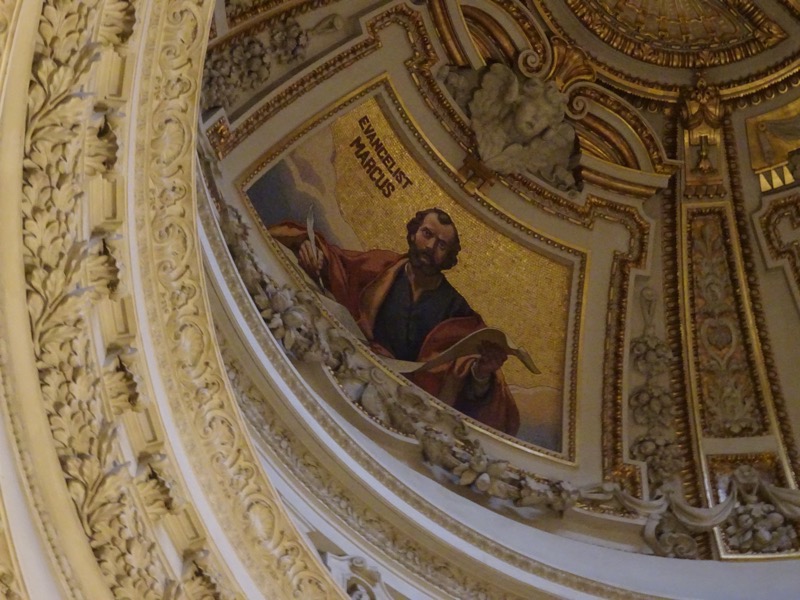 There is a small museum full of models, sketches and pieces of the original mosaics etc.
There is a small museum full of models, sketches and pieces of the original mosaics etc.


 yale for scale by a piece of a column…
yale for scale by a piece of a column… 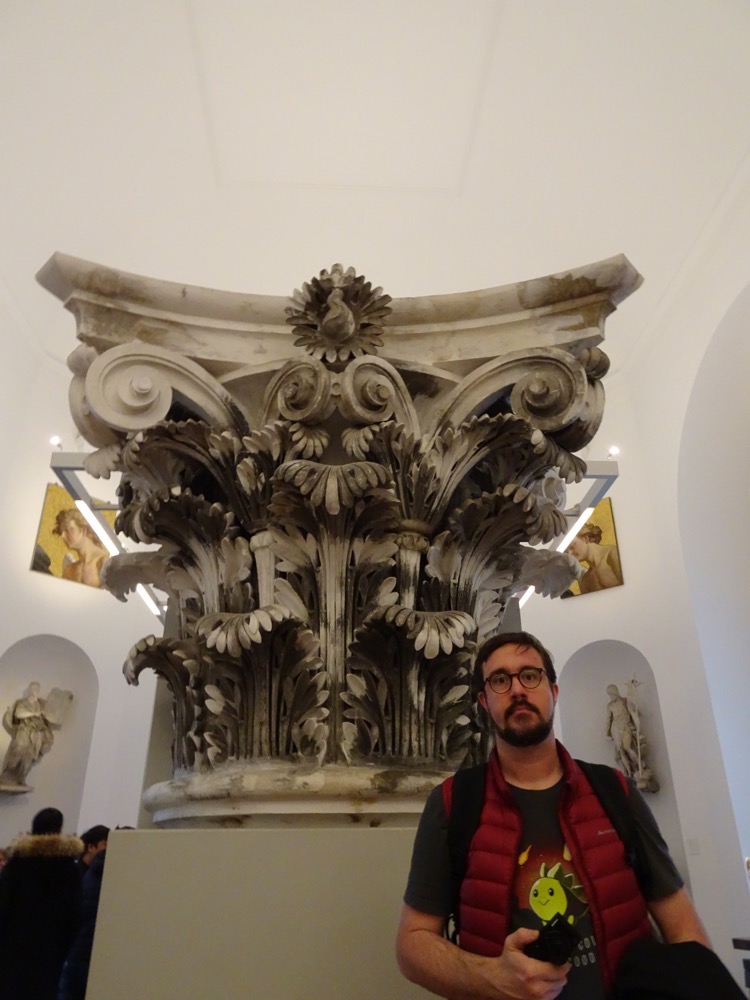 The crypts beneath the church.
The crypts beneath the church.


 Across the river from the Church is the Altes Museum or Old Museum which is a great name for an archaeological museum – it was built on Museum Island in Berlin and only recently restored in 2010/11. It has cool stuff in it like Greek urns, helms and paintings from old masters and all sorts of shit… but MONDAY!
Across the river from the Church is the Altes Museum or Old Museum which is a great name for an archaeological museum – it was built on Museum Island in Berlin and only recently restored in 2010/11. It has cool stuff in it like Greek urns, helms and paintings from old masters and all sorts of shit… but MONDAY!
Don’t know if we will have time to double back tomorrow. We will see.
 Some sculptures on the Schloss Bridge near Museum Island.
Some sculptures on the Schloss Bridge near Museum Island.

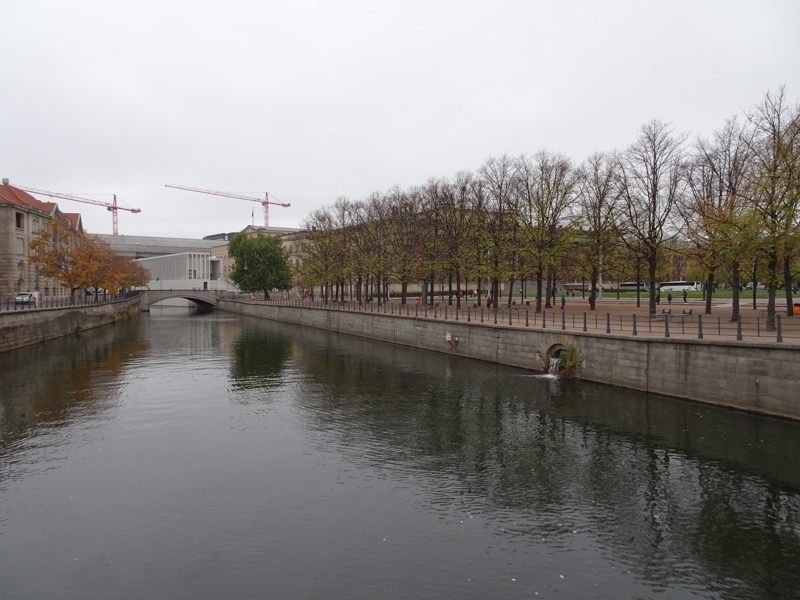 A little further down the Bundesstraße 2 which goes straight through the middle of the city is the Neue Wache, or New Guardhouse, memorial. It is the “Central Memorial of the Federal Republic of Germany for the Victims of War and Dictatorship”. Built in 1816 the Neue Wache was designed by the architects Schinkel and Sachs in the German-Greek Revival style. Originally built as a guardhouse for the troops of the Prussian crown prince, it has been used as a war memorial since 1931.
A little further down the Bundesstraße 2 which goes straight through the middle of the city is the Neue Wache, or New Guardhouse, memorial. It is the “Central Memorial of the Federal Republic of Germany for the Victims of War and Dictatorship”. Built in 1816 the Neue Wache was designed by the architects Schinkel and Sachs in the German-Greek Revival style. Originally built as a guardhouse for the troops of the Prussian crown prince, it has been used as a war memorial since 1931.  The Käthe Kollwitz sculpture, Mother with her Dead Son, sculpture is the only thing housed inside as a monument to Unknown Soldiers.
The Käthe Kollwitz sculpture, Mother with her Dead Son, sculpture is the only thing housed inside as a monument to Unknown Soldiers.
 Next stop was the Berlin State Opera or the ‘Staatsoper Unter den Linden’, presumably the same opera house which, inconveniently located, caused the tank standoff at Checkpoint Charlie given that from 1949 to 1990 it housed the state opera of East Germany. It is the permanent home of the ‘Staatsoper Unter den Linden’ opera company.
Next stop was the Berlin State Opera or the ‘Staatsoper Unter den Linden’, presumably the same opera house which, inconveniently located, caused the tank standoff at Checkpoint Charlie given that from 1949 to 1990 it housed the state opera of East Germany. It is the permanent home of the ‘Staatsoper Unter den Linden’ opera company.  Humboldt University…
Humboldt University… Beside the opera house is the Bebelplatz public square which is bound by the Opera House, the Humboldt University, and St Hedwig’s Catholic Cathedral. Today, the Bebelplatz is most famous for it being the site of the Nazi book burnings that occurred here on the 10th May 1933. The burnings were initiated and hosted by the nationalist German Student Association… seriously, the students were burning the books. They started collecting books on the 6th Mary and dragged the contents of the Institut für Sexualwissenschaft library into the square before they invited Propaganda Minister Joseph Goebbels to come and give a speech before setting fire to the books. Also in attendance were members of the Nazi Students’ League, the Sturmabteilung (“brownshirts”), the SS, and members of Hitler Youth groups. They burned around 20,000 books. 🙁
Beside the opera house is the Bebelplatz public square which is bound by the Opera House, the Humboldt University, and St Hedwig’s Catholic Cathedral. Today, the Bebelplatz is most famous for it being the site of the Nazi book burnings that occurred here on the 10th May 1933. The burnings were initiated and hosted by the nationalist German Student Association… seriously, the students were burning the books. They started collecting books on the 6th Mary and dragged the contents of the Institut für Sexualwissenschaft library into the square before they invited Propaganda Minister Joseph Goebbels to come and give a speech before setting fire to the books. Also in attendance were members of the Nazi Students’ League, the Sturmabteilung (“brownshirts”), the SS, and members of Hitler Youth groups. They burned around 20,000 books. 🙁  Monument to Reiterstandbild König Friedrich II von Preußen, or Fredrick the Great.
Monument to Reiterstandbild König Friedrich II von Preußen, or Fredrick the Great.
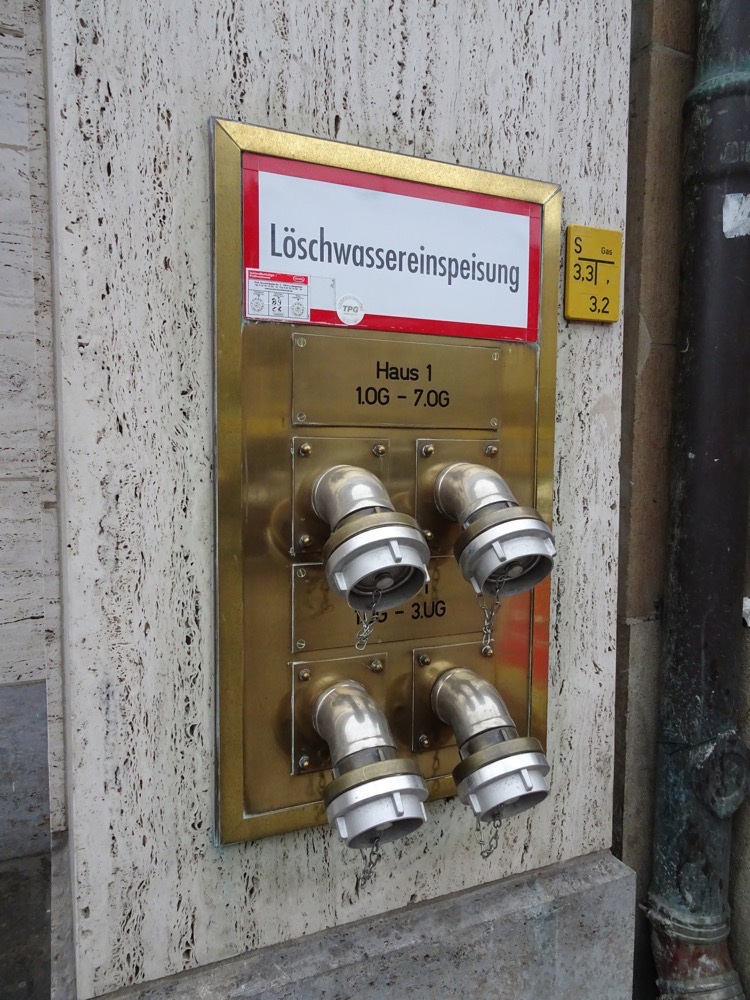 Berlin’s Microsoft offices.
Berlin’s Microsoft offices.
 In the foyer of Mercedes Benz in Berlin… a tiny mirror-balled Smart Car. No idea why.
In the foyer of Mercedes Benz in Berlin… a tiny mirror-balled Smart Car. No idea why.
 Saw this ad for an internet plan and nearly cried… #fraudband #nbn #auspol
Saw this ad for an internet plan and nearly cried… #fraudband #nbn #auspol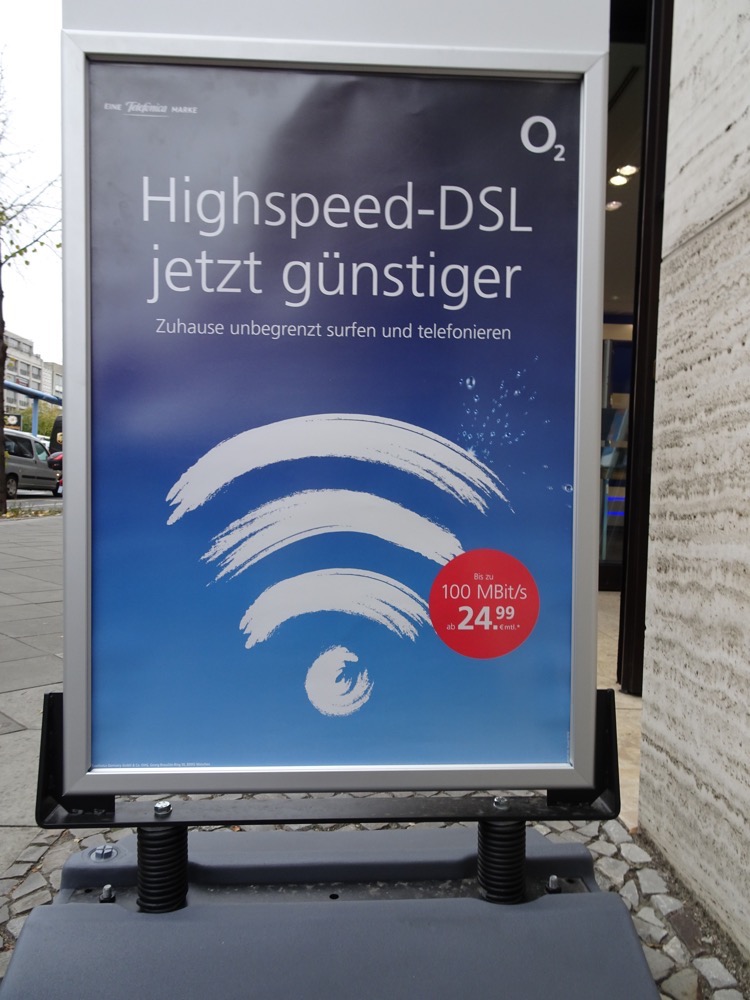 We stopped and had some lunch at a great cafe called, Nante-Eck for some typical stodgy German fare – there was soup and sausages and mustards, flammkuchen and yale sized beer!
We stopped and had some lunch at a great cafe called, Nante-Eck for some typical stodgy German fare – there was soup and sausages and mustards, flammkuchen and yale sized beer!
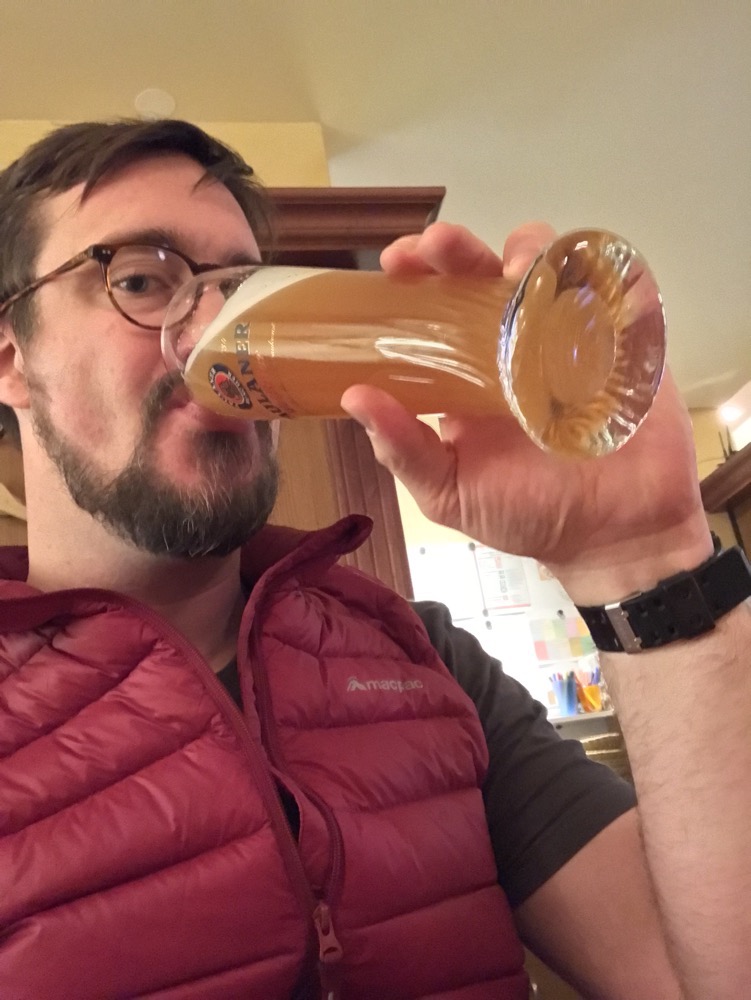 Crayfish bisque for me
Crayfish bisque for me Charlottenburg mixed sausage platter for yale.
Charlottenburg mixed sausage platter for yale. And some creme fraice, onion and bacon flammkuchen to share. Delicious.
And some creme fraice, onion and bacon flammkuchen to share. Delicious.
After lunch we were making our way to the Brandenburg Gate only to find the entire place crawling with police – LOTS of police. And road closures. Seems the G20 Investment Summit is in town and the only people who didn’t know it was us because we’ve been unable to read newspapers for the last five weeks and who knows what day it is anymore?!


 The Brandenburg Gate is an 18th-century neoclassical monument built by the Prussian king Frederick William II after the (somewhat temporary) successful restoration of state order during the early Batavian Revolution. Victory gates for the win! Build ’em while you can.
The Brandenburg Gate is an 18th-century neoclassical monument built by the Prussian king Frederick William II after the (somewhat temporary) successful restoration of state order during the early Batavian Revolution. Victory gates for the win! Build ’em while you can. After the 1806 Prussian defeat at the Battle of Jena-Auerstedt, Napoleon used the Brandenburg Gate for an enormous chest beating triumphal procession, and apparently, he took the Quadriga (the four horse statue) from the top of the gates and sent them to Paris. After Napoleon’s defeat in 1814 and the Prussian occupation of Paris by General Ernst von Pfuel, the Quadriga was returned to Berlin (probably with very poor grace) and it was redesigned by Karl Friedrich Schinkel who added the goddess, Victoria, and gave her a Prussian eagle and an Iron Cross on her lance within a wreath of oak leaves.
After the 1806 Prussian defeat at the Battle of Jena-Auerstedt, Napoleon used the Brandenburg Gate for an enormous chest beating triumphal procession, and apparently, he took the Quadriga (the four horse statue) from the top of the gates and sent them to Paris. After Napoleon’s defeat in 1814 and the Prussian occupation of Paris by General Ernst von Pfuel, the Quadriga was returned to Berlin (probably with very poor grace) and it was redesigned by Karl Friedrich Schinkel who added the goddess, Victoria, and gave her a Prussian eagle and an Iron Cross on her lance within a wreath of oak leaves. When the Nazis ascended to power, they too used the gate as a symbol of party power. Following Germany’s surrender and the end of the war, the governments of East and West Berlin restored it in a joint effort. The bullet holes were patched but were still visible. Today, the space leading up to the gate is used for public gatherings and even concerts (somewhat like the Washington Mall) as it can fit up to a million people. The gates looked really impressive but was hard to get a photo without the police presence in the way.
When the Nazis ascended to power, they too used the gate as a symbol of party power. Following Germany’s surrender and the end of the war, the governments of East and West Berlin restored it in a joint effort. The bullet holes were patched but were still visible. Today, the space leading up to the gate is used for public gatherings and even concerts (somewhat like the Washington Mall) as it can fit up to a million people. The gates looked really impressive but was hard to get a photo without the police presence in the way.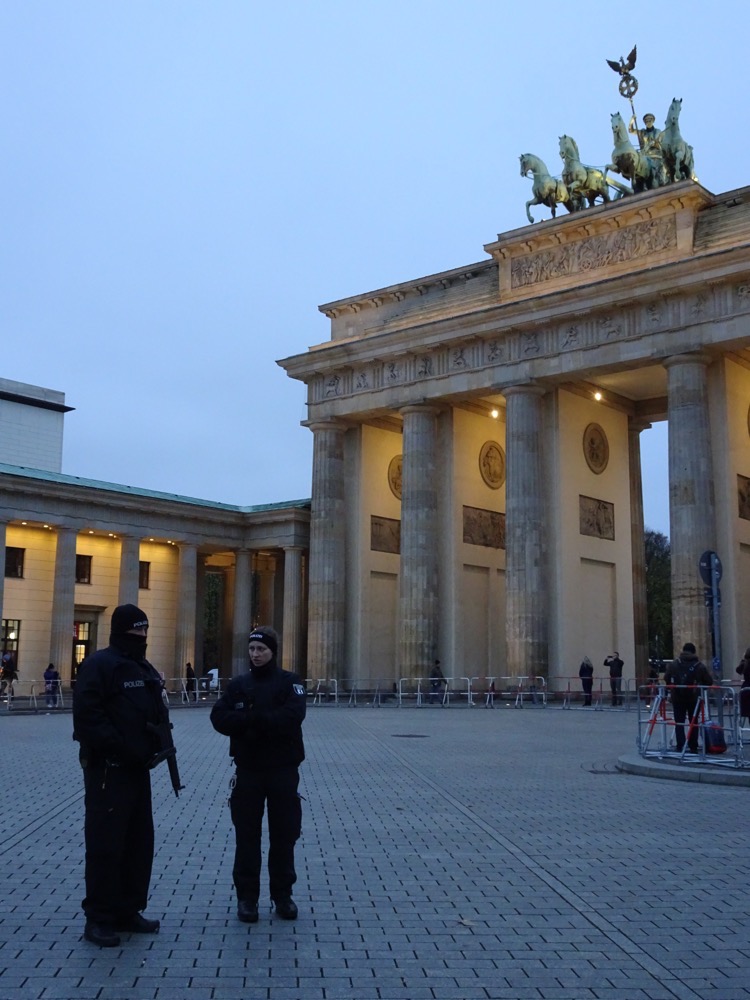

More cops on the roofs of surrounding buildings! The other side of the gate – minus cops.
The other side of the gate – minus cops.
 Not far from the Brandenburg Gates is the famous Reichstag Building, which was constructed to house the ‘Imperial Diet of the German Empire’ – which is an interesting way to describe the houses of parliament. It was opened in 1894 and parliament was housed there until 1933 when it was severely damaged during an arson attack. After WWII the building fell into disrepair.
Not far from the Brandenburg Gates is the famous Reichstag Building, which was constructed to house the ‘Imperial Diet of the German Empire’ – which is an interesting way to describe the houses of parliament. It was opened in 1894 and parliament was housed there until 1933 when it was severely damaged during an arson attack. After WWII the building fell into disrepair.
About half a kilometre or so away is the Memorial to the Murdered Jews of Europe which is also known as the Holocaust Memorial. It was designed by architect Peter Eisenman and engineer, Buro Happold in remembrance of the Jewish victims of the Holocaust. The memorial covers a 19,000 square-metre space that is filled with 2,711 concrete slabs or “stelae”, arranged in a grid pattern on an undulating ground. The stelae are 2.3m in length, and 1m in width, but they vary in height from only 0.2m to a towering 4.7m high. They are organized in long rows, 54 of them lie north-south, and 87 lie east-west at right angles but set slightly askew.
 According to Eisenman’s project text, the stelae are designed to produce an uneasy, confusing atmosphere, and the whole sculpture aims to represent a supposedly ordered system that has lost touch with human reason. Some people interpret the memorial to resemble a graveyard, though the creators say that was not the main aim.
According to Eisenman’s project text, the stelae are designed to produce an uneasy, confusing atmosphere, and the whole sculpture aims to represent a supposedly ordered system that has lost touch with human reason. Some people interpret the memorial to resemble a graveyard, though the creators say that was not the main aim. The deeper you descend into the memorial, the more you lose visual contact with the outside world. You start to feel hidden from other people, you walk quietly alone, the stelae are smooth and cold and sound echoes through the stones. You will occasionally catch glimpses of people moving through the stelae in the distance but you feel ostracised and separate from them. It is easy to lose your fellow travellers as you wander deeper into the memorial, and it is apparently designed to evoke a sense of loss and separation as you can no longer see your companions – a feeling that would have been so desperate among the Jewish community during the Holocaust.
The deeper you descend into the memorial, the more you lose visual contact with the outside world. You start to feel hidden from other people, you walk quietly alone, the stelae are smooth and cold and sound echoes through the stones. You will occasionally catch glimpses of people moving through the stelae in the distance but you feel ostracised and separate from them. It is easy to lose your fellow travellers as you wander deeper into the memorial, and it is apparently designed to evoke a sense of loss and separation as you can no longer see your companions – a feeling that would have been so desperate among the Jewish community during the Holocaust.
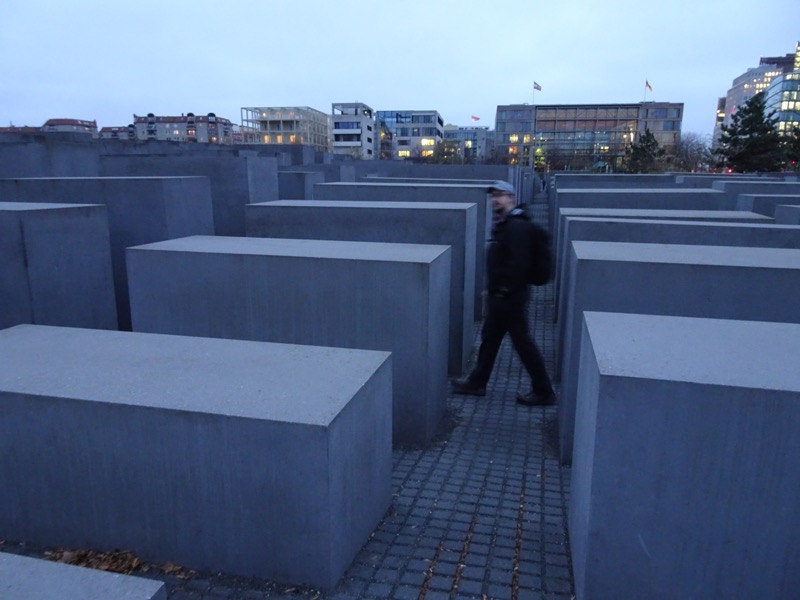
 Beneath the memorial is a “Place of Information” museum that holds the names of roughly three million Jewish Holocaust victims. Unfortunately, we didn’t get to visit the museum because it is Monday, but the memorial itself is a very moving place to visit.
Beneath the memorial is a “Place of Information” museum that holds the names of roughly three million Jewish Holocaust victims. Unfortunately, we didn’t get to visit the museum because it is Monday, but the memorial itself is a very moving place to visit.


There are signs at various entry points to the memorial advising visitors of appropriate behaviour here – unfortunately, people seem to be too disconnected from the horrors that this memorial is designed to remind us of. While we were visiting there were children playing hide and seek among the stelae, there were tourists posing for selfies on top of the stelae and other jumping from stone to stone for mid-air action shots. It was sad to see such disrespectful behaviour in what should be a place of thoughtful reflection.

It’s not just today though, it’s apparently a long-standing problem at this site:
https://petapixel.com/2017/01/21/artist-shames-disrespectful-holocaust-memorial-tourists-using-photoshop/
After our visit to the memorial, we head back to the hotel. It is just too cold and miserable to want to be out of an evening. Thank goodness for ciders and Lieferando.de 😀
NOTE: If you think Berlin is looking lovely this time of year – you’d be wrong. It was cold, allegedly 5-7C (feels like 0-1C with the windchill), and overcast, and the photos above are the result of careful composition. I’ve been deliberately cutting all the crap out of my viewfinder all day. Berlin feels like a really UGLY city, full of grime, litter, graffiti, traffic and building obstructions and … especially after having just come from the fairytale-like medieval city of Gdansk.
To demonstrate what I mean, I have included a handful of ‘not so carefully composed’ street scenes.








